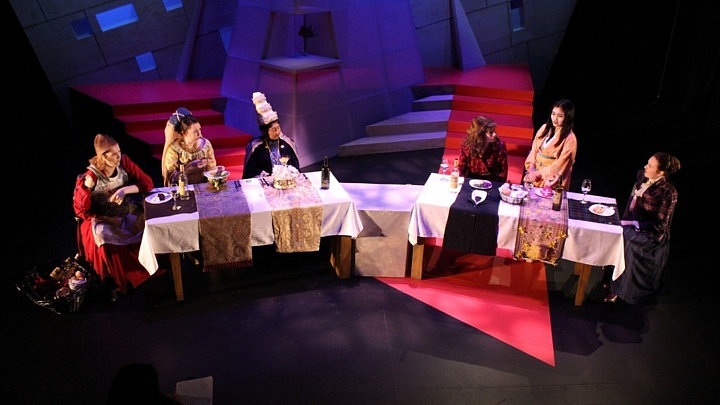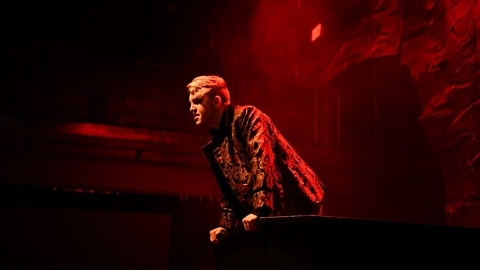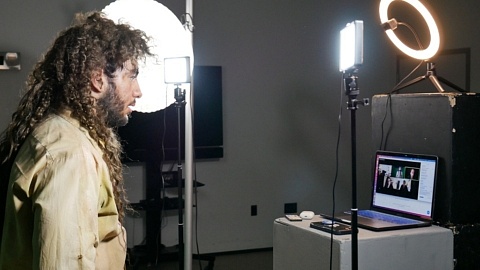For nearly two years, theatre lovers have felt entrapped in their own little purgatories. Artists have been unable to perform on stages, and audiences been...
Tarndeep Pannu writes,
The DART Mainstage talkback is an integral part of the mandate of our Dramatic Arts degree. It brings the praxis element of theatre, the weaving together of theory and practice, to the fore, so that every student has an opportunity to learn from the theatrical process.
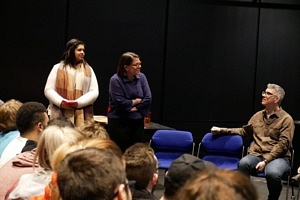
Tarndeep Pannu, Karen Fricker, and Gavin Fearon at the Top Girls talkback. Photo by David Vivian.
When approaching the talkback for Top Girls, all of us involved – Professor Karen Fricker, Michelle Mohammed, teaching assistant Hayley Malouin, and myself – were determined to have this talkback be about the work, the topics and themes that were present in the show, and getting the student body to express their opinions and insights. It is rare, in my experience, to have an all-female play that showcases different types of women and their struggles. The Brock University Dramatic Arts production of Top Girls speaks to racism, ageism, ableism, sexism, and classism – all pressing issues to those who identify as female. Even though it was written in the 1980s, this play is topical to the time we are currently in, making it important to showcase and engage with. I believe that female empowerment and hard work need to be praised and encouraged, especially in a department and artistic landscape that is majority female. This play and subsequent talkback invites critical dialogue between the students, faculty, and the mainstage company, and allows for us to engage with one another as a department.

DART Top Girls talkback. Photo by David Vivian.
In light of this, we reached out to various students – both those involved in and those who attended Top Girls – to continue the conversation. This piece includes both extensions of conversations that began during the talkback – such as actors Manchari Paranthahan and Meryl Ochoa’s deliberations on race, representation, and racialization in theatre, and actor Emma McCormick’s thoughts on neurodiversity in relation to her character Angie – as well as topics that we felt important to discuss, but didn’t quite reach during the talkback – such as actor Kristina Ojaperv’s contribution here on feminism, class, and labour in relation to her role as the Waitress. Also included are my reflections on audience response, in which I spoke with members of the student body post-talkback, and crew member Ian Ball’s thoughts on the possible benefits, for students of any gender, of engaging in feminist and female-driven work.
We hope you enjoy this continuing conversation – and, of course, feel free to join the discussion.
On race, racialization, and white feminism Manchari Paranthahan writes,
To cast racialized women in a play like Top Girls means that this play needs to be more than just a play about “women” as a universalized identity. When we started working on this show, we talked as a creative team about how white feminism heavily influenced this play. It was, after all, written by a white woman in 1980s Britain, during second wave feminism and in the height of Thatcherism. Second wave feminism has often been critiqued for being white-centric and not factoring in the “micro-politics” or intersectionality of all women, so it wasn’t a surprise that racialized actors weren’t written into this show.
When we do see women of colour on stage, in the media, or represented in general, it is often when we are sexualized, stereotyped, villainized, or mocked. We do see racialized actors on theatre stages, but not as often as we see white actors. In this way, racialized actors have an added pressure of representing all racialized people as a whole because of how rare it is to see a racialized body on stage – an issue white actors do not face.

Manchari Paranthahan as Nell in Top Girls. Photo by Jacob Bergsma.
We see the reality for racialized people in any industry explicitly played out in this production of Top Girls. Two women of colour play Nell and Win, who work at the Top Girls Employment Agency next to Marlene, who has just gotten a promotion that the other women have also applied for. To see women of colour playing these high status characters in a “high-flying” office challenges stereotypes surrounding women of colour in the workplace – that they are not as capable, competent or hardworking than their white colleagues. To also see Marlene, played by and written as a white woman, win the promotion over women of colour in this production also speaks to issues of systemic racism, micro-aggressions, and classism that racialized people still face in the workplace.
So what does it mean when you put us on stage? What space is there in theatre for women of colour when we aren’t sexualized, mocked, or dismissed? Do you want to see us when you aren’t laughing at us? It isn’t enough to just cast racialized people. When you put a racialized actor on stage next to white actors, you automatically make a comment about racialized bodies because of how excluded racialized people have historically been from the stage. Being a part of this production of Top Girls was an empowering experience, because of the diversity and depth of the characters I had the opportunity to play as an actor. While the specifics of this opportunity and this play offer a layered representation of experiences for racialized actors, we must not lose the momentum that this conversation brings to campus moving forward.
On labour, gender, and class Kristina Ojaperv writes,
I played the role of the Waitress and Shona in this production of Top Girls. From the moment I accepted my role and started to do research on how to approach the character of the Waitress, I ran into quite a few issues. First of all, most of the study guides, even simple information sheets, did not even list her as a character. While, granted, she might not have a lengthy historical background like many other characters in this first act, the fact that descriptions of her role were continually missing was concerning and illuminating.
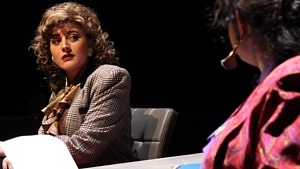
Kristina Ojaperv as Shona in Top Girls. Photo by Jacob Bergsma. It is interesting to note that no production photographs exist of the Waitress.
Sharon Ammen (1996) assessed her role perfectly in one of few scholarly articles on Top Girls that mention the Waitress: “During a frantic forty-five minute meal, the waitress remains invisible as a subject, and highly visible as an object; silent and harried she is ordered about by everyone, and ignored by all” (86). It is also worth mentioning that different productions have different approaches to this character, with some even making the decision to have multiple waitresses.
To clarify, the Waitress does not have any lines in the play; rather, in the script she is only mentioned in stage directions. It is not often specified when exactly she enters or exits. The Waitress does not have a voice, and is therefore often treated as invisible, even as we see an array of women telling their stories (both their misfortunes and fortunes), discussing what has led them down their respective paths, and uplifting each other. We celebrate women speaking out; yet, as exemplified by this first act, we can often forget that there are still so many silent women right next to us.
When Top Girls director Danielle Wilson offered me this role, she emphasized that, even though the Waitress does not have any lines, she is very important. This is true; there would be no dinner without the Waitress, at least through the realistic lens that was occasionally employed by this production. The logistics that go into playing the Waitress are not mentioned in the script, and it might not even shine through in the production. This was indeed my intention: to highlight the labouring woman’s invisibility by trying to perfectly execute my own labour.
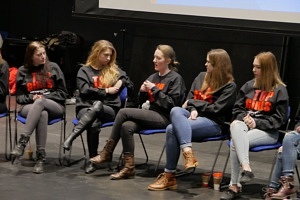
Cast and crew of Top Girls. Photo by David Vivian.
I find the clear difference between Marlene and the Waitress quite interesting. In the final act, in a scene between Marlene and her sister Joyce, Marlene says that she does not believe in class; she claims that everyone can do what they want, if they have what it takes; somewhat contradictorily, she also remarks that she does not like the working class. This scene demonstrates how Marlene’s achieved status and privilege make it easy for her to make such remarks. This speaks directly to the views of British Prime Minister Margaret Thatcher – who Marlene is greatly inspired by – on women and labour, and to the obstacles faced by working class women during Thatcher’s tenure. It is thus telling of Marlene’s specific feminist position that, in her fantasy feminist dinner, she employs a working class woman whose labour is rendered invisible.
Further, in the first scene the only non-historical characters from the contemporary world are Marlene and the Waitress. It can thus be argued that a binary exists, with Marlene at one and the Waitress at the other. These two women are the only possibilities for women in the “real” world; you can either become a Marlene, a top-notch “ballbreaker,” or the Waitress, a silent and exploited labourer, who is so invisible in this classist feminist context that she does not even have a name.
On representation and diversity in casting Meryl Ochoa writes,
Top Girls provides an amazing opportunity, in my opinion, for women to play multiple roles that offer strong and complex characters. I was fortunate enough to be cast as characters that both pushed me to my limits and made my work as an actor very enjoyable!
Something that is really important to me is being able to represent an Asian character, and this show has provided me with such an opportunity – not once, but three times. It is visibly evident that I am not the same race as one of the characters in the play — Lady Nijo, who is an actual person in history, is Japanese — and I was seriously worried from the moment I got cast about the issues I could come across with regards to “not being the right Asian.” My worry disappeared as conversations with director Danielle Wilson and assistant director Michelle Mohammed developed. We discussed playing the truth of the character, and looking at what I can bring to her. I would much rather see more opportunities for diversity on stage, and this includes providing actors such as myself with opportunities to play roles such as Nijo, than worry about having to wait for a character who is Filipino (like myself) Frankly, I have not come across one yet in my studies. Further, I should not have to resort to solely writing my own plays (I am not a playwright) in order to be cast in roles that represent me. Actors who are in the same position as I am should not necessarily have to be cast only as characters that are explicitly of the same ethnic background as they are — this is not the case for white actors, and should therefore not be the case for me.
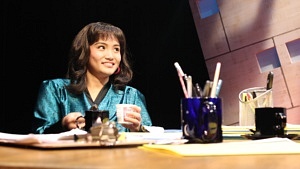
Meryl Ochoa as Win in Top Girls. Photo by Jacob Bergsma.
In my studies, I have come across many characters that, if I were to play them, could be seen to pose logistical concerns because they are related to other (white) characters in the play. I understand the implications of diversity and visibility on stage — how race implies a difference in the story of a character, big or small — but I also don’t believe in colour-blind casting “just because.” I have been on the hunt for a “golden rule” regarding whether characters of colour should only be played by actors of the same race. Truthfully, this is a worry that I will carry with me for a long time, if I choose to pursue a career in acting, and a question I do not yet have the answer to. At the end of the day, however, I want aspiring actors to feel that they are represented on stage, in whatever way they identify, and that they have a chance to play strong and multi-dimensional characters.
While there is no definitive way for me to know whether I will miss out on playing characters because of how I look, I can say that, in my studies, I have never felt any regret or restraint when it comes to which roles I have been able to play so far.
On the importance of feminist theatre and feminism in a many-gendered context Ian Ball writes,
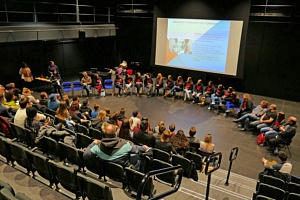
DART Top Girls talkback. Photo by David Vivian.
I believe it benefits male students to engage in feminist work, regardless if they are depicted or not. While I can only speak to my own sensibilities, having the opportunity to work on a project that allows exploration of non-male-centric narratives seems like something that male artists should be seeking out in droves. I don’t want to see the same points of view represented over and over again, nor do I think working in a representationally homogeneous environment is particularly interesting. I want to have my ideas and preconceived notions challenged.
If working in an environment that is robustly feminist gives the opportunity for someone to consider the realities of those around them, it is reason enough to seek it out. Feminism is a rising tide that lifts all boats. Approaching art from an arguably peripheral position allows for a personal reflection on my own approach to creating art, and encourages me to actively listen. On Top Girls, I had the privilege not only to learn from the incredibly talented people around me, but also view to the theatre-making process from directions that would have never otherwise occurred to me.
I feel that decentralizing yet still including male contributions is attainable through remaining cognizant of the narratives that are put forth in theatre, and the narratives that are presented throughout academia. Asking questions of an audience and creative team is a measuring tools for “good art” (a nebulous term, granted). Asking questions can be a powerful tool that shines a light on the areas that have been neglected for too long. We all deserve to have an equal voice, and we all benefit from exposure to the thoughts and ideas of as many people from as many walks of life as we possibly can.
On neurodiversity and actor work Emma McCormick writes,
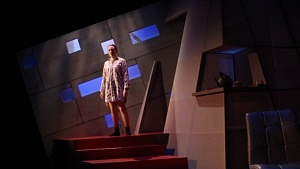
Emma McCormick as Angie in Top Girls. Photo by Jacob Bergsma.
I was asked in the Top Girls talkback about whether or not Angie identifies on the autism spectrum, or if, conversely, it is possible that she has a mental illness. The question, as well as the answer, is complicated for me. There are many considerations at play here. My answer has always been that I did not personally play Angie as identifying with any specific diagnosis. It is my opinion that to play symptoms, especially when not directly informed or encouraged by the play text, is to limit the character to a reductive medical/psychological definition, and does not take into account the full potential of the human being. That being said, I think there is great value in the audience’s vision of Angie being different than my own. If someone in the audience finds value seeing character interact with the onstage world in ways that they relate to, or that helps them appreciate a different perspective than their own, I think it is best to allow room for this interpretation. It is important to keep audience interpretation and actor intent distinct from one another; as an actor, I cannot play Angie through the audience’s eyes, just as an audience can’t be privy to an actor’s entire process.
From the outset, I saw Angie as someone whose circumstances prevented her from reaching her full potential. Because she is obviously uninspired by her home and school life, her passions are directed toward strange and fantastical hobbies (like practicing telekinesis, for example) that will not lead her into the glitzy world of corporate success, like Marlene, nor land her a practical job, as Joyce might want. It is my belief that if someone had taken the time to help Angie find her own path to success, or even provided some encouragement and positivity, Angie could succeed in anything. She is called stupid, lazy and frightened, and deemed unable to “make it” – all this by the very people who refuse to help her try. This, to me, has parallels in the experience of many children today – of different classes, races, sexual identities, and abilities. I wanted the audience to see Angie and remember that her experience is not isolated, and perhaps consider how to help those like Angie that they see off the stage.
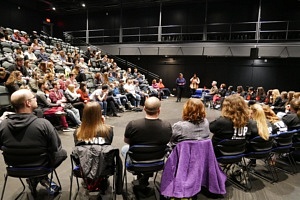
DART Top Girls talkback. Photo by David Vivian.
In terms of practical acting sense, when approaching Angie it was important to not treat her as anything too different from my own experience. Sure, she believes in her own mystical powers, and the ghostly kitten, and isn’t afraid to lick blood, but she does so with motivation, vulnerability, and intense emotion. On a fundamental level, I can relate to her. In developing mannerisms and the character body, I followed impulse without regard for social graces. I wasn’t playing “weird”; I was just playing Angie.
Related Posts
The Brock Dramatic Arts department’s fourth year students have been working hard on their final production of this academic year. Ouroboros is a piece of...
What’s the best way to describe Sheila Callaghan’s play Fever/Dream? Simply put by actor Joanna Tran: “like a fever dream.” Director Gyllian Raby...
The Brock Dramatic Arts department’s fourth year students have been working hard on their final production of this academic year. Ouroboros is a piece of...
What’s the best way to describe Sheila Callaghan’s play Fever/Dream? Simply put by actor Joanna Tran: “like a fever dream.” Director Gyllian Raby...
Leave a Reply (Cancel Reply)
Twitter Feed
Blogroll
DARTcritics.com is partially funded by the Marilyn I. Walker School of Fine and Performing Arts, in support of student learning; experiential education; student professionalization; public engagement with the teaching, learning and production activities of the Department of Dramatic Arts; new ways of thinking; and the nurturing of links with our communities.

